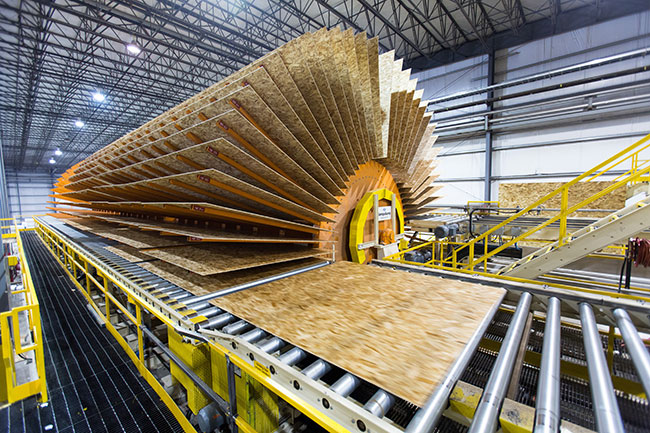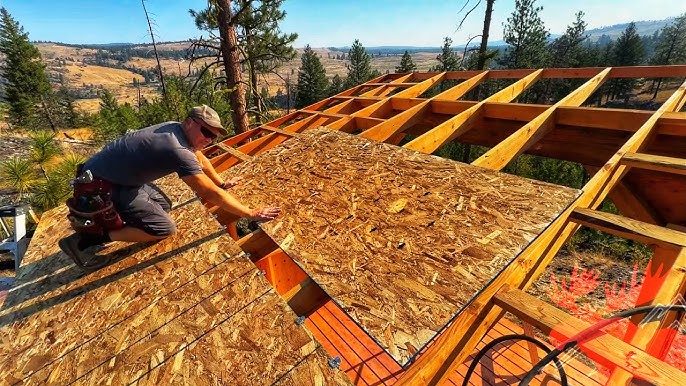Oriented Strand Board (OSB) for Construction: A Comprehensive Guide.
Oriented Strand Board (OSB) has become a popular material in the construction industry due to its versatility, durability, and cost-effectiveness. Whether you’re building a new home, renovating an existing structure, or working on a commercial project, OSB offers a range of benefits that make it an attractive choice for builders and contractors. In this comprehensive guide, we’ll explore everything you need to know about OSB, including its uses, advantages, disadvantages, and how it compares to other construction materials.

Table of Contents
- What is OSB?
- History of OSB
- Manufacturing Process of OSB
- Types of OSB
- Advantages of OSB in Construction
- Disadvantages of OSB
- OSB vs. Plywood: A Comparison
- Applications of OSB in Construction
- How to Choose the Right OSB for Your Project
- Installation Tips for OSB
- Maintenance and Care for OSB
- Environmental Impact of OSB
- Future Trends in OSB Usage
- FAQs About OSB
- Conclusion
1. What is OSB?
Oriented Strand Board (OSB) is an engineered wood product that is made by compressing and bonding together strands of wood with adhesives. The strands are oriented in specific directions to enhance the strength and durability of the board. OSB is commonly used in construction for sheathing, flooring, and roofing applications.
Key Features of OSB:
- Strength: OSB is known for its high strength-to-weight ratio, making it suitable for structural applications.
- Versatility: It can be used in a variety of construction projects, from residential to commercial.
- Cost-Effective: OSB is generally more affordable than other engineered wood products like plywood.
2. History of OSB
OSB was first developed in the late 1970s as an alternative to plywood. The need for a more cost-effective and sustainable building material led to the creation of OSB, which quickly gained popularity in the construction industry. Over the years, advancements in manufacturing technology have improved the quality and performance of OSB, making it a preferred choice for many builders.
3. Manufacturing Process of OSB
The manufacturing process of OSB involves several steps:
- Wood Selection: Logs are selected and debarked.
- Strand Production: The logs are cut into thin strands.
- Drying: The strands are dried to reduce moisture content.
- Blending: The strands are mixed with adhesives and wax.
- Orienting: The strands are oriented in specific directions to enhance strength.
- Pressing: The strands are compressed under high pressure and temperature to form panels.
- Cutting and Finishing: The panels are cut to size and finished as required.

4. Types of OSB
There are several types of OSB available, each designed for specific applications:
- OSB/1: General-purpose boards for non-structural applications.
- OSB/2: Load-bearing boards for dry conditions.
- OSB/3: Load-bearing boards for humid conditions.
- OSB/4: Heavy-duty load-bearing boards for humid conditions.
5. Advantages of OSB in Construction
OSB offers several advantages that make it a popular choice in construction:
- Cost-Effective: OSB is generally more affordable than plywood, making it a cost-effective option for large projects.
- Strength and Durability: OSB has a high strength-to-weight ratio, making it suitable for structural applications.
- Versatility: OSB can be used in a variety of applications, including sheathing, flooring, and roofing.
- Sustainability: OSB is made from fast-growing, renewable wood species, making it an environmentally friendly option.
- Consistency: OSB panels are manufactured to consistent standards, ensuring uniform quality.
6. Disadvantages of OSB
While OSB has many advantages, there are also some disadvantages to consider:
- Moisture Sensitivity: OSB can swell and lose strength when exposed to moisture for extended periods.
- Weight: OSB is heavier than plywood, which can make it more difficult to handle and install.
- Appearance: OSB has a rough appearance, which may not be suitable for visible applications.
7. OSB vs. Plywood: A Comparison
OSB and plywood are both popular engineered wood products used in construction. Here’s a comparison of the two:
| Feature | OSB | Plywood |
|---|---|---|
| Cost | Generally more affordable | More expensive |
| Strength | High strength-to-weight ratio | High strength |
| Moisture Resistance | Less resistant to moisture | More resistant to moisture |
| Weight | Heavier | Lighter |
| Appearance | Rough | Smooth |
| Sustainability | Made from fast-growing wood | Made from slower-growing wood |
8. Applications of OSB in Construction
OSB is used in a variety of construction applications, including:
- Sheathing: OSB is commonly used as sheathing for walls, roofs, and floors.
- Flooring: OSB is used as subflooring in residential and commercial buildings.
- Roofing: OSB is used as roof sheathing to provide a stable base for roofing materials.
- Furniture: OSB is sometimes used in the construction of furniture and cabinetry.
- Packaging: OSB is used in the packaging industry for crates and pallets.


Caption: OSB is commonly used as sheathing for walls, roofs, and floors.
9. How to Choose the Right OSB for Your Project
When choosing OSB for your project, consider the following factors:
- Application: Determine the specific application for which you need OSB (e.g., sheathing, flooring, roofing).
- Grade: Choose the appropriate grade of OSB based on the load-bearing requirements and environmental conditions.
- Thickness: Select the right thickness of OSB based on the structural requirements of your project.
- Moisture Resistance: Consider the moisture resistance of the OSB, especially if it will be used in humid or wet conditions.
10. Installation Tips for OSB
Proper installation is crucial to ensure the performance and longevity of OSB. Here are some tips:
- Acclimate the Panels: Allow the OSB panels to acclimate to the environment before installation.
- Use Proper Fasteners: Use the appropriate fasteners (e.g., nails, screws) and spacing to secure the panels.
- Seal the Edges: Seal the edges of the OSB panels to prevent moisture penetration.
- Follow Manufacturer Guidelines: Always follow the manufacturer’s installation guidelines and recommendations.
11. Maintenance and Care for OSB
To ensure the longevity of OSB, proper maintenance and care are essential:
- Protect from Moisture: Keep OSB panels dry and protect them from prolonged exposure to moisture.
- Inspect Regularly: Regularly inspect OSB panels for signs of damage or wear.
- Repair as Needed: Repair any damaged areas promptly to prevent further deterioration.
12. Environmental Impact of OSB
OSB is considered an environmentally friendly building material for several reasons:
- Renewable Resource: OSB is made from fast-growing, renewable wood species.
- Efficient Use of Wood: The manufacturing process of OSB makes efficient use of wood, minimizing waste.
- Recyclable: OSB can be recycled at the end of its life cycle.
13. Future Trends in OSB Usage
The use of OSB in construction is expected to continue growing due to its cost-effectiveness, versatility, and sustainability. Future trends may include:
- Improved Moisture Resistance: Advances in manufacturing technology may lead to OSB with enhanced moisture resistance.
- Increased Use in Green Building: OSB is likely to play a significant role in green building projects due to its sustainability.
- New Applications: OSB may find new applications in areas such as modular construction and prefabricated buildings.
14. FAQs About OSB
Q1: What is OSB used for in construction?
A1: OSB is commonly used for sheathing, flooring, and roofing in residential and commercial construction.
Q2: Is OSB stronger than plywood?
A2: OSB and plywood have similar strength properties, but OSB has a higher strength-to-weight ratio.
Q3: Can OSB be used outdoors?
A3: OSB can be used outdoors, but it should be protected from prolonged exposure to moisture.
Q4: How does OSB compare to plywood in terms of cost?
A4: OSB is generally more affordable than plywood, making it a cost-effective option for large projects.
Q5: Is OSB environmentally friendly?
A5: Yes, OSB is considered environmentally friendly because it is made from renewable wood species and the manufacturing process minimizes waste.
Q6: Can OSB be painted or stained?
A6: OSB can be painted or stained, but it has a rough texture that may not provide a smooth finish.
Q7: How long does OSB last?
A7: The lifespan of OSB depends on the application and environmental conditions, but with proper maintenance, it can last for many years.
Q8: Can OSB be used for flooring?
A8: Yes, OSB is commonly used as subflooring in residential and commercial buildings.
Q9: What are the disadvantages of OSB?
A9: The main disadvantages of OSB are its sensitivity to moisture, weight, and rough appearance.
Q10: How is OSB made?
A10: OSB is made by compressing and bonding together strands of wood with adhesives, with the strands oriented in specific directions to enhance strength.
15. Conclusion
Oriented Strand Board (OSB) is a versatile, durable, and cost-effective building material that has become a staple in the construction industry. Its high strength-to-weight ratio, sustainability, and wide range of applications make it an attractive choice for builders and contractors. While OSB has some disadvantages, such as sensitivity to moisture and a rough appearance, its benefits often outweigh these drawbacks. As advancements in manufacturing technology continue to improve the quality and performance of OSB, its use in construction is expected to grow even further. Whether you’re working on a residential, commercial, or industrial project, OSB is a reliable and efficient material that can help you achieve your construction goals.

By understanding the properties, advantages, and applications of OSB, you can make informed decisions about its use in your construction projects. With proper installation and maintenance, OSB can provide long-lasting performance and contribute to the success of your building endeavors.